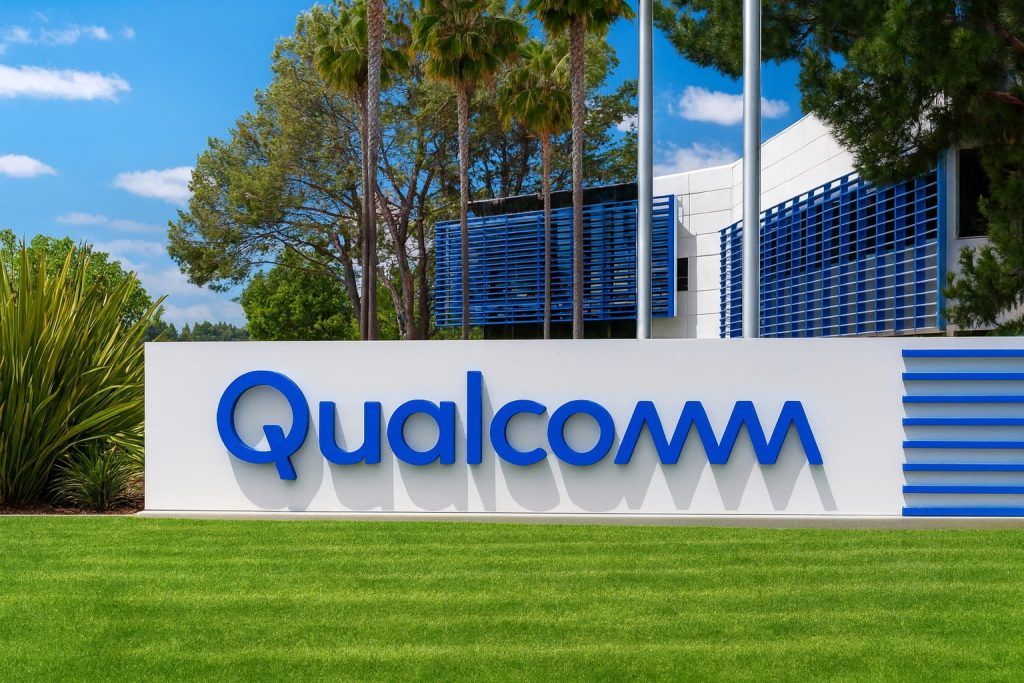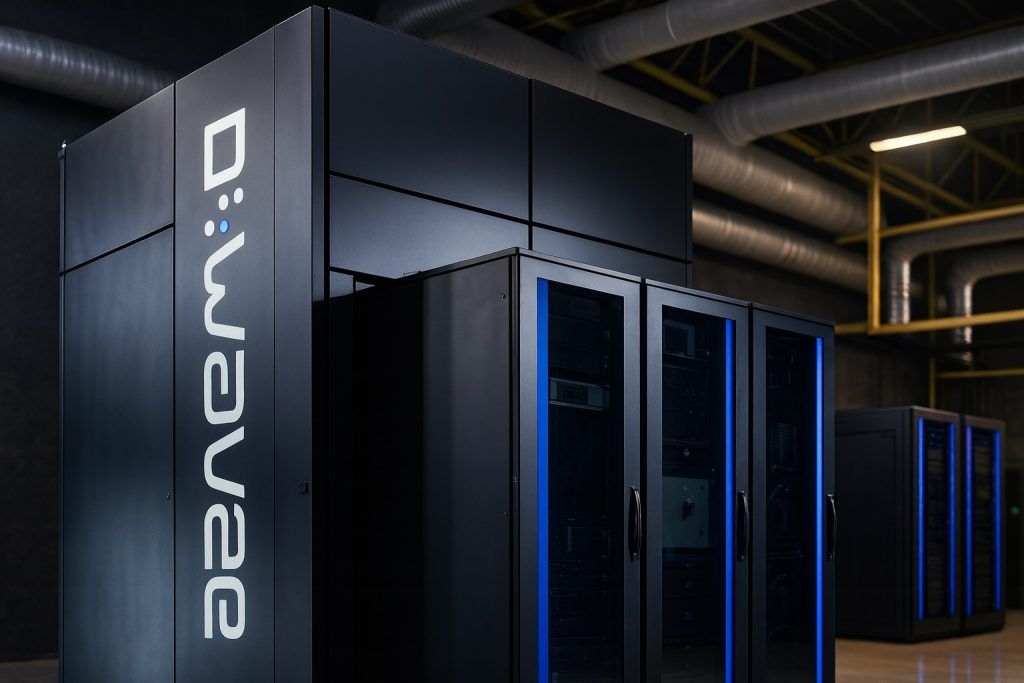- 5,000% Rally: Rigetti Computing (NASDAQ: RGTI) went from penny-stock levels under $1 to an all-time high around $56 per share in mid-October 2025 – a nearly 50-fold increase within the year [1]. This meteoric rise epitomizes the 2025 quantum computing stock boom, outpacing even hot peers like IonQ (+700% year-over-year) and D-Wave (+2,000%+) [2].
- Recent Pullback: After peaking on October 15, Rigetti’s stock plunged roughly 25% in a matter of days as investors took profits [3]. Shares fell back to the mid-$40s by October 21 [4] (closing at $43.31 on Oct. 20 [5]) and have since hovered around $40 as of October 27, 2025 – still astronomically higher than a year ago despite the pullback.
- Government Stake Buzz: RGTI spiked again late last week (up ~15% over Thursday-Friday) after a Wall Street Journal report that the Trump administration is exploring taking minority equity stakes in quantum computing firms [6]. Rigetti’s stock jumped over 8% on Friday alone in reaction [7], although the U.S. Commerce Department denied any active negotiations with the companies [8].
- Big Deals Fueling Hype: A string of real-world wins ignited investor enthusiasm. In late September, Rigetti (with partner QphoX) secured a $5.8 million U.S. Air Force contract to develop quantum networking technology, and announced $5.7 million in purchase orders for two of its new Novera quantum computers (its first-ever hardware sales) [9]. The company also rolled out a 36-qubit quantum processor on its cloud platform – concrete milestones that suggested Rigetti’s quantum ambitions are translating into tangible progress [10].
- Bubble Concerns: Despite a ballooning market valuation near $15–18 billion, Rigetti’s annual revenue is only about $8–10 million with deep ongoing losses [11]. The stock trades at an eye-popping 1,500×+ sales multiple [12], far beyond traditional tech valuations. This disconnect between valuation and fundamentals has led analysts to raise bubble red flags [13] – one analyst bluntly called RGTI “massively overvalued” given its ~$17B market cap “despite questionable fundamentals and no near-term path to profitability” [14].
- Analysts Cautiously Optimistic: Every Wall Street analyst covering Rigetti rates it a “Buy,” reflecting long-term optimism about its quantum technology. However, their average 12-month price targets are only in the mid-$20s – roughly 50% below RGTI’s recent trading levels [15]. Even bullish analysts warn the stock’s parabolic run “may be unsustainable,” predicting a pullback as reality catches up to hype [16]. In other words, experts like Rigetti’s potential but question whether its current sky-high stock price can be justified without significant earnings or breakthroughs.
Record Surge and Wild Volatility
Rigetti Computing’s stock has been on a rollercoaster ride in 2025. At the start of the year, RGTI traded for mere cents. By October 15, it had rocketed to a record closing high of $56.34 [17], an almost 50-fold increase in under 10 months. In the week leading up to that peak, Rigetti’s share price exploded from the mid-$40s to the mid-$50s, including a 25% spike in a single day on October 13 [18]. This frenzied rally lifted Rigetti’s market capitalization into the mid-teens of billions of dollars, an astonishing feat for a company with minimal revenue.
Importantly, Rigetti’s surge wasn’t an isolated phenomenon – it rode a wave of speculative excitement around quantum computing stocks. Other pure-play quantum firms also saw stratospheric gains: IonQ’s stock is up roughly 700% year-over-year, while D-Wave Quantum has surged an even more staggering 2,000–4,000% in the same period [19]. Investors have been piling into the sector’s promise, driving a speculative “quantum boom” across what some dub the “Quantum Four” (Rigetti, IonQ, D-Wave, and Quantum Computing Inc.).
However, euphoria turned to whiplash by mid-October. After topping out, Rigetti’s quantum rocket abruptly lost altitude. On Thursday, October 16, RGTI plunged nearly 15% intraday, falling from the $50s down into the $ Forty’s as traders rushed to lock in gains [20]. The next day (Oct. 17) and the following Monday saw further declines, with Rigetti sliding to $43.31 by Oct. 20 close [21] – a swift ~25% retreat from its peak. Reuters noted that shares of Rigetti and its peers had “climbed to record highs last week before sliding into a string of daily declines” [22], underscoring the volatility. Even after this dip, RGTI remained up thousands of percent year-on-year, reflecting both the thrill and the peril of its remarkable run-up [23].
Notably, there was no bad news from Rigetti itself behind the sudden sell-off. Instead, the pullback was driven by broader market jitters and technical factors. Observers pointed out that after such a parabolic rise, it was almost inevitable some investors would hit the brakes at the first hint of trouble [24]. In this case, a scare in the banking sector on Oct. 16 (unrelated to Rigetti) spooked the market and sent traders scrambling for safe havens – high-flying speculative names like RGTI were among the hardest hit [25]. The plunge was exacerbated by profit-taking and a realization that even in the futuristic realm of quantum tech, stocks “don’t go up in a straight line forever,” as one analyst remarked [26].
There were also some technical and insider signals that gave traders pause. By mid-October the stock was extremely “overbought” on technical charts [27] [28], prompting savvy investors to take profits. Additionally, news surfaced that Rigetti’s CEO, Subodh Kulkarni, had quietly sold 1,000,000 shares – essentially his entire personal stake – earlier in the year [29]. This insider sale (albeit months prior) loomed in the background as a reminder that even Rigetti’s leadership wasn’t betting on infinite upside. Combined with the stock’s torrid run-up, these factors gave traders another reason to cash out after the euphoric climb [30]. In short, after an unbelievable rally, RGTI got a reality check – even a “quantum leap” in stock price can be yanked back to earth once momentum cools.
As of this week, Rigetti’s stock appears to be searching for stability. After the mid-October drop, RGTI traded in the mid-$30s to mid-$40s range last week. It closed Friday (Oct. 24) around $38.84 [31], and was ticking around the $40 level on Monday Oct. 27. The current 52-week trading range stretches from well under $1 to nearly $60 [32] [33] – encapsulating the dizzying highs and lows of Rigetti’s quantum saga so far.
U.S. Government Hype Re-Ignites Quantum Mania
Just as Rigetti’s stock was cooling off, new hype from Washington sent quantum stocks jumping again. On October 23, a Wall Street Journal report claimed that President Donald Trump’s administration is in discussions to acquire equity stakes in several quantum computing companies as part of a plan to secure U.S. leadership in this critical technology [34]. The idea is that in exchange for federal funding, the government would take minority ownership positions – a highly unusual move that underscores how strategically important quantum computing is becoming.
The mere hint of potential federal investment acted like rocket fuel for the sector. Shares of Rigetti, IonQ, D-Wave, and others surged between 8% and 16% after the report came out [35]. Rigetti’s stock leapt nearly 16% in two sessions on Thursday and Friday [36] [37], briefly pushing it back toward the mid-$40s. IonQ and D-Wave similarly saw big rebounds. The rally came even as the U.S. Commerce Department quickly denied that any active negotiations were underway with those firms [38]. In other words, the government interest at this stage is just talk – but that talk was enough to spur a mini quantum buying frenzy on Wall Street.
Analysts said the prospect of Uncle Sam as a stakeholder validated the strategic importance of companies like Rigetti and could ultimately bolster their finances. “Even preliminary federal involvement could boost Rigetti’s access to capital and strengthen its position against larger rivals such as IBM and Google,” noted one analysis [39]. The symbolic weight of a government stake – essentially Washington putting its money where its mouth is – would confer credibility on Rigetti’s technology and provide a backstop of support. Traders, for their part, didn’t wait to parse the details: the moment the news hit, quantum stocks ripped higher, trading on the narrative of government “endorsement” of the industry.
It’s worth noting the policy context here. The U.S. government has ramped up efforts to secure supply chains in critical tech sectors, from semiconductors to quantum, especially amid rising competition with China. Converting federal grants into equity stakes is one novel strategy the administration has floated [40]. As IG Markets’ chief analyst Chris Beauchamp put it, “quantum computing offers the chance to really revolutionize the U.S. economy,” and the administration appears willing to do things “in an unconventional way” to ensure American leadership [41].
For Rigetti, the episode provided a timely boost in sentiment. Coming off the recent pullback, the company suddenly was at the center of a major policy news cycle. While the actual outcome is uncertain (no official program or funding has been confirmed), the signal alone was enough – reinforcing the perception that Rigetti is among the key players in quantum tech that policymakers want to cultivate. It also highlighted the widening gap between hype and reality: even without any concrete new deal or data from Rigetti, a government rumor swung its market cap by billions in a day. Such is the state of the quantum computing frenzy in 2025.
Real Wins Behind the Quantum Hype
Despite the speculative nature of Rigetti’s run, it hasn’t been only hype – the company’s recent achievements and partnerships have given investors something tangible to latch onto. In fact, much of the rally through September and early October was fueled by a drumbeat of positive developments from Rigetti’s business operations and R&D labs, which suggested that the startup is edging closer to commercial viability in quantum computing.
Some of the key catalysts in recent weeks include:
- Military Contract: In late September, Rigetti (in partnership with Dutch startup QphoX) was awarded a 3-year, $5.8 million contract by the U.S. Air Force Research Lab to develop quantum networking technologies [42]. This project will explore connecting Rigetti’s superconducting quantum processors via QphoX’s specialized microwave-to-optical transducers, advancing the ability to network quantum computers. The deal not only brings non-dilutive funding but also serves as a vote of confidence from the defense community – a signal that Rigetti’s expertise is valued for real-world applications (in this case, potentially secure communications or linking quantum systems). Such military-backed projects lend credibility to a field sometimes dismissed as purely experimental.
- First System Sales: Around the same time, Rigetti secured purchase orders totaling ~$5.7 million for two of its “Novera” quantum computers [43]. These are 9-qubit tabletop quantum systems that an Asian electronics manufacturer and a U.S. AI startup have ordered for delivery in 2026. It marks Rigetti’s first-ever hardware product sales – a milestone in transitioning from research to revenue. For a company that booked only $1.8 million in total revenue last quarter [44], landing multi-million dollar orders was a breakthrough moment. It demonstrated actual demand (albeit early and modest) for Rigetti’s quantum technology. If these deliveries go smoothly, they could open the door to more commercial orders and partnerships.
- New Quantum Processor: Technologically, Rigetti notched a win by launching a new 36-qubit quantum processor (dubbed “Cepheus-1-36Q”) available through its cloud platform [45]. This chip is built from four connected 9-qubit chips, reflecting Rigetti’s bet on a modular “chiplet” architecture to scale up qubit count. The company reported a two-qubit fidelity of ~99.5% on this system [46], an encouraging level of error rate for a multi-chip quantum processor. The rollout expanded the capacity of Rigetti’s Quantum Cloud Services and showed that Rigetti is continuing to push the frontier on performance. Each technical leap – higher qubit counts, better fidelities – is closely watched by investors as a barometer of progress toward a useful quantum computer.
Each of these announcements fed the narrative that Rigetti is not just about hype – it’s hitting real milestones on the road to quantum computing’s holy grail. “These tangible achievements have helped fuel the narrative that Rigetti is making real strides, not just riding hype,” noted TechStock² (TS2) after the flurry of news [47]. The promise of concrete revenue (from government contracts and product sales) gave fundamentally minded investors something to cheer, even as momentum traders were piling in for the speculative ride. In short, Rigetti managed to show it can play on both fronts: delivering science and securing deals, while capturing imaginations about the future.
It’s also worth mentioning that Rigetti has been forging strategic partnerships to bolster its capabilities. For instance, the company signed an MOU with India’s Centre for Development of Advanced Computing (CDAC) in September to explore co-developing hybrid quantum-classical computers [48], indicating global interest in its technology. Earlier in the year, Rigetti partnered with manufacturing giant Quanta Computer, which invested $35 million and committed $100 million in manufacturing support over five years [49] – a move aimed at scaling up production of Rigetti’s chips. And Rigetti was selected to lead a DARPA program (Quantum Benchmarking) that could provide stable R&D funding through 2033 [50]. These undertakings, while not as flashy as the stock chart, form the groundwork that could determine Rigetti’s long-term success or failure.
The recent deals collectively suggest that Rigetti is transitioning from pure R&D toward early commercialization. This is precisely what many investors had hoped to see. It’s no coincidence that as these developments hit the newswires in late September, Rigetti’s stock began its parabolic ascent – jumping from ~$15 in early September to over $30 by the end of that month [51], then into the $40s and $50s by early October. The story evolved from “startup with potential” to “company with actual contracts and products,” which is a powerful narrative shift. Of course, $5 or $10 million in orders is still microscopic relative to Rigetti’s multibillion valuation, but it represents the first trickle of a revenue stream that optimists hope will eventually turn into a river.
Sky-High Valuation Spurs Bubble Warnings
Rigetti’s fairy-tale stock rally has a flip side: a sobering financial reality. The company remains an early-stage venture with minimal revenue, yet its market capitalization, at one point above $15 billion, implies expectations more fitting for an established tech giant. This yawning gap between valuation and fundamentals has many observers questioning whether quantum fever has gotten ahead of itself.
The numbers are stark. In 2024, Rigetti’s total revenue was in the single-digit millions (around $8 million) [52], and it continues to operate at a significant loss (Rigetti, like most quantum startups, is burning cash to fund R&D). Yet even after the recent pullback, the stock market values Rigetti in the tens of billions. By one measure, RGTI at its peak was trading above 1,500 times its annual sales [53] – an astronomical multiple. For comparison, high-growth tech darlings in the AI space might trade at 20–50 times sales; 1,500× is almost unheard of. “Despite Rigetti’s ~$15–18B market valuation, its annual revenue is only ~$8–10M… The stock now trades at an astronomical 1,500×+ sales multiple,” TS2 noted bluntly in an analysis of the rally [54].
This disconnect hasn’t escaped the notice of analysts and financial media. In fact, some are sounding the alarm. Seeking Alpha recently published a piece titled “Rigetti Computing: Cloud Castle With Ground-Level Reality,” in which the author blasted the stock as “massively overvalued” given its ~$17–18 billion market cap “despite questionable fundamentals and no near-term path to profitability” [55]. Likewise, a Yahoo Finance commentary pointed out that Rigetti generated only ~$8M in revenue last year and saw its latest quarterly sales decline year-over-year [56], arguing that the valuation had become unmoored from reality.
Skeptics argue that what we’re seeing in Rigetti (and its quantum peers) has shades of past speculative bubbles – where excitement over a revolutionary technology drives stocks to extreme heights long before the business case is proven. The dot-com boom of 1999–2000 is an oft-cited parallel, as is the more recent EV/SPAC frenzy in 2021. In Rigetti’s case, the technology (quantum computing) is undeniably promising, but commercial viability could still be many years away. In the meantime, the company will likely continue posting net losses and may need to raise more capital (diluting shareholders) to fund its operations. That sets up a risky dynamic: any stumble in technical progress or tightening of financial conditions could trigger a harsh correction in these richly valued stocks.
Even some of Rigetti’s strong supporters concede the valuation is ahead of itself. “There’s a huge disconnect between where quantum technology is today and the prices of these stocks,” one venture investor commented off-record. “We’re basically valuing [Rigetti] as if it’s already solved quantum computing at scale, which it hasn’t – no one has yet.” This sentiment is reflected in the cautious language coming from Wall Street analysts (despite their bullish ratings, as we’ll see next). The consensus is that Rigetti’s current stock price bakes in a best-case scenario: that the company eventually develops a truly commercial quantum computer and becomes one of the dominant players in a multi-billion-dollar industry. If anything goes awry on the way to that destination, the stock could have a long way to fall.
It’s instructive to note that even Rigetti’s CEO selling shares has been interpreted as a warning sign. While insider sales can happen for many reasons, the fact that Rigetti’s chief executive unloaded essentially his entire personal stake earlier in 2025 (at prices far below today’s levels) suggests that he may not have anticipated the stock going on such a historic run [57]. To skeptics, that underscores how disconnected the rally has been from the company’s internal reality – if the CEO didn’t “HODL,” why should retail investors? (Of course, one could counter-argue that the CEO needed liquidity or made a mistake selling too early. Nonetheless, it has added to the narrative of caution.)
All of this has led to a growing chorus asking: Is Rigetti a quantum “bubble”? The term has even made its way into mainstream coverage. For instance, TS2 ran a headline calling Rigetti’s rise a “Quantum Boom or Bubble” and posing the question of sustainability [58]. The concern is not that quantum computing isn’t real – few doubt the technology’s potential – but rather timing and valuation. Are investors prematurely bidding up prices by years, if not decades? And if so, will there be a painful correction?
For now, Rigetti’s lofty valuation remains an article of faith in its future. As long as the stock stays elevated, it also provides the company an opportunity – for example, Rigetti raised $350 million via an at-the-market stock offering in mid-2025 [59], taking advantage of investor appetite to beef up its cash war chest (now around $570 million on hand [60]). Those funds will be crucial to survive the long road ahead. But new investors buying in at $40 or $50 a share are effectively betting that Rigetti will eventually grow into this valuation. It’s a high-stakes wager on a paradigm-shifting payoff that may be years out of reach.
Analysts: Quantum Dreams Meet Cautious Reality
Despite the red flags, Wall Street analysts covering Rigetti remain broadly optimistic about the company’s long-term prospects – even as they caution about the stock’s near-term trajectory. As of this writing, every major sell-side analyst who officially rates RGTI has it pegged as a “Buy” or equivalent, according to multiple reports [61]. This unanimity in bullish ratings is notable; it signals that professional analysts, who have pored over Rigetti’s technology and roadmap, genuinely see transformative potential in what the company is doing. They’re effectively saying: Rigetti could be a winner in quantum computing, and long-term investors should want a piece of that.
However, these same analysts are far from sanguine about the current share price. The average 12-month price target among Wall Street firms is in the $25–30 range [62] (estimates vary, but all are dramatically below where RGTI has been trading). That implies analysts, on average, foresee the stock nearly halving from recent levels. In fact, even the most bullish published target as of October (from Benchmark) was around $50 [63] – roughly equal to the stock’s peak, and an outlier vs. peers. Many other analysts have targets in the $18–30 range [64].
What explains this discrepancy? Essentially, analysts’ models are grounded in more conservative assumptions than the market’s current euphoric pricing. They do expect Rigetti to grow and achieve milestones – but not enough to justify a $40+ share price in the next year. For instance, Needham’s analyst might believe Rigetti will successfully deliver its 84-qubit system and maybe sign a few more deals, but even that might only warrant a ~$25 stock in their DCF model. The rest of the valuation would be “hype premium.” Hence, the consensus that the stock is ahead of itself.
Several analysts have gone on record with warning language. As TS2 recounts, even bullish analysts have said Rigetti’s recent run-up “may be unsustainable” and that it “might be too early” to buy at these heights absent a major breakthrough or a sharp dip [65]. In other words, they like the company, but not necessarily the stock at this price. This kind of nuanced stance – optimistic on fundamentals, cautious on valuation – is common during bubbles. Analysts don’t want to dismiss the technology (which could indeed be game-changing), but they also want to guide investors not to chase hype blindly.
For example, Morgan Stanley’s tech desk (hypothetically) might issue a note saying: “Rigetti is a promising pure-play in quantum computing… However, at the current price, the stock reflects flawless execution through 2030, which we view as overly optimistic. We would wait for a better entry point.” Similarly, Zacks highlighted that RGTI’s ABR (average brokerage recommendation) is a Buy, but accompanied by “overly optimistic recommendations” that may not fully account for the execution risks [66] – a polite way of saying analysts could be wearing rose-colored glasses to some extent.
To be fair, analysts are impressed by what Rigetti has achieved technically and the fact that it’s one of the few public pure-plays in quantum. “For Rigetti, it’s quantum computing supremacy or bust,” noted a Motley Fool report, emphasizing that the company is a pure-play with no backup business – which can be seen as a positive (focus and upside) or a negative (all eggs in one basket) [67]. The pure-play nature keeps Rigetti “extremely focused” on quantum innovation, but also means if quantum takes longer than expected, Rigetti doesn’t have other revenue streams to fall back on [68]. This all-or-nothing profile is part of what makes RGTI stock so exciting and volatile.
It’s also noteworthy that Rigetti’s peers have drawn similar caution. For instance, some analysts have warned that IonQ’s stock (IONQ) could retrace significantly after its own 10x leap, and that D-Wave’s valuation is hard to justify given its early-stage revenue. So Rigetti isn’t being singled out – it’s part of a broader pattern of analyst enthusiasm for the field, tempered by realism about timelines and earnings.
One concrete data point reflecting analyst skepticism is the price target disparity. As mentioned, ~$25 is the consensus one-year target [69]. That basically assumes Rigetti’s stock will “come back to Earth” (as TS2 phrased it [70]) once the initial hype cools and investors realize the long slog ahead. On the other hand, there are also wild quantitative forecasts out there feeding the bulls – one momentum-based model recently projected RGTI could rise another 160% to trade between $82 and $150 by early 2026 if the rally resumes unabated [71]. That huge range of possible outcomes highlights the uncertainty and divergence in expectations. The professionals are essentially betting on a significant pullback, while some speculative models (and likely some retail traders on forums) are betting on another explosive leg up.
For readers, the key takeaway is that expert opinion is mixed, but skewing cautious in the near term. Rigetti has captured Wall Street’s attention and praise – no one wants to miss what could be “the next Nvidia” if quantum computing truly takes off. Yet, seasoned observers also recall the adage that trees don’t grow to the sky. The stock can’t go up 5,000% every year; at some point, valuations matter. Rigetti is now at that junction where bullish narrative meets the hard questions: Can the company execute? How fast will revenue scale? What’s the competitive landscape? On those fronts, analysts are eager to see more evidence before raising their targets, even if they maintain buy ratings for the long run.
Quantum Computing Boom: Hype vs. Reality
Rigetti’s rise is occurring against the backdrop of a wider boom in quantum computing – and a heated debate about how quickly the technology will mature. The market’s excitement is palpable: quantum computing startups are going public (e.g. via SPACs) at multi-billion valuations [72], established tech giants are pouring money into quantum R&D, and investors are scrambling to identify the potential “winners” of a future quantum age. But many experts caution that the quantum revolution will not happen overnight.
On one hand, the opportunity is enormous. Quantum computers operate on principles of quantum mechanics, tapping phenomena like superposition and entanglement to potentially compute far faster than classical computers on certain problems. If realized at scale, they could solve problems in minutes that would take classical supercomputers millennia [73]. This could transform industries – from breaking encryption and optimizing logistics to discovering new drugs and materials – and even reshape geopolitical power (hence government interest). It’s no wonder quantum computing is often described in revolutionary terms, and why companies like Rigetti inspire such speculative fervor.
On the other hand, practical quantum computing remains a very challenging goal, and most scientists agree we’re still years away from machines that outperform classical computers in broad use. Today’s quantum processors (Rigetti’s included) have relatively small numbers of qubits and are prone to errors (“noise”) that require correction. Error-corrected, scalable quantum computers are the ultimate prize, but getting there is a complex engineering marathon. “Most experts agree that practical, error-corrected quantum computers are still years away from widespread use – some say not until the 2030s or even 2040,” TS2 noted in its outlook [74]. That implies a possibly long “quantum winter” period where companies must continue heavy R&D spending without reaping major revenues, which can be brutal for investors if patience wears thin.
Even tech industry leaders have offered differing timelines. In February, Microsoft unveiled a new quantum chip and boldly declared that a useful quantum computer is “years, not decades away” [75] – an upbeat view suggesting late 2020s might see breakthroughs. IBM, a frontrunner in quantum, has laid out a roadmap aiming for a practical quantum computer by 2029 [76]. Conversely, Nvidia’s CEO (known for his work in AI) opined earlier that quantum computing’s practical impact could still be two decades away, which temporarily dampened quantum stocks back in January 2025 [77]. These mixed messages reflect both rapid progress and remaining hurdles in the field.
Within the quantum sector, companies are taking different approaches: Rigetti and IBM use superconducting qubits, IonQ uses trapped ions, others explore photonic or silicon spin qubits. Each approach has pros and cons, and it’s far from certain which (if any) will win out. It’s conceivable that multiple winners will emerge if different quantum technologies prove useful for different tasks. In the meantime, all these firms – Rigetti, IonQ, D-Wave, Google, IBM, etc. – are racing to improve qubit counts and fidelities. The broader trend is undeniable: more money, talent, and interest is flooding into quantum computing than ever before. Just in 2025, we saw Finland’s IQM raise $320M for quantum hardware [78], another startup (Infleqtion) ink a SPAC deal at a $1.8B valuation [79], and big tech companies like Amazon and Microsoft expanding their quantum cloud services. Quantum has moved from a niche R&D topic to a headline-grabbing frontier.
For Rigetti, this rising tide is both fortuitous and challenging. Fortuitous because it validates the market – customers and governments are starting to pay for quantum solutions, and investors are willing to fund the effort. Rigetti’s recent deals (Air Force, etc.) show it can snag its share of the pie. But challenging because the hype brings intense scrutiny and competition. Rigetti must contend with far larger competitors: Google (Alphabet) and IBM have far more resources and have also achieved notable quantum milestones. There’s also the likes of IonQ, which recently agreed to acquire Oxford Ionics for $1 billion to deepen its tech stack [80], and D-Wave, which focuses on quantum annealing and is expanding its quantum-as-a-service offerings.
The market’s exuberance in 2025 suggests investors are effectively betting that at least one of these pure-play quantum firms will become the “IBM of quantum” in the future – and Rigetti, with its full-stack approach (building hardware and software), is seen as a prime candidate. But until someone actually delivers a quantum computer that clearly outperforms classical ones on useful tasks, doubts will linger. We are in what might be called the “transitional” era: quantum computing is moving from theory and lab experiments toward real products and use cases, but it’s not quite there yet. This makes for a volatile mix of excitement and uncertainty, as perfectly exemplified by Rigetti’s stock chart.
As a broader trend, we’re also seeing retail investors and social media play a role in hyping quantum stocks, akin to how “meme stocks” took off in recent years. In fact, in October a financial firm relaunched a Meme Stock ETF to track retail trader favorites – and Rigetti was mentioned as a candidate for inclusion. The combination of a futuristic narrative (“quantum computing will change everything!”) and a low starting share price (RGTI was under $1, which psychologically invites “lottery ticket” buying) made Rigetti a perfect recipe for viral attention on platforms like Reddit and X. This retail fervor can amplify moves dramatically but can also reverse suddenly, adding another layer of risk.
In summary, the quantum computing sector’s boom is real but must be viewed in context. The promise is driving stock prices to dizzying heights, while the reality of building those quantum machines is a slow grind. Rigetti exists at the crux of this tension, symbolizing both the dreams (a small company making it big by conquering a new frontier) and the challenges (huge technical uncertainty and a valuation built on future hope).
Outlook: High Stakes on the Horizon
Looking ahead, Rigetti faces a pivotal question common to all breakthrough tech darlings: Can it turn revolutionary potential into a sustainable business? The next few months and years will be crucial in determining whether RGTI’s stock saga is remembered as the start of a genuine tech success story or a cautionary tale of speculation.
Short-Term Volatility: In the near term, expect the wild swings to continue. Most experts predict that Rigetti’s stock will remain extremely volatile, mirroring the flux of news and sentiment in the quantum space [81]. Double-digit percentage moves in a single day have become almost routine for RGTI, and that turbulence likely isn’t over yet. “In the short term, the market is likely to remain highly volatile,” one market analysis observed, noting that quantum stocks will gyrate with each new headline and shifting sentiment [82]. Any announcement of a technical breakthrough, a big contract win, or a positive government action could send shares soaring anew – conversely, any disappointments, delays, or broader market sell-offs could trigger another rapid dive. Traders and investors should be prepared for a bumpy ride, where fortunes could change with a single press release or rumor.
Divergent Forecasts: The spread of forecasts for RGTI is unusually wide, underscoring the uncertainty. On one end, momentum-driven models and exuberant retail traders foresee significant upside – for example, one quantitative forecast recently suggested that if the current uptrend resumed, Rigetti’s stock could rise another ~160% over the next three months, potentially trading as high as $80–$150 by early 2026 [83]. This ultra-bullish scenario assumes enthusiasm for quantum reignites and lifts all boats. On the other end, traditional equity analysts expect a more sobering correction: as noted, the one-year consensus target around $25–$30 [84] implies roughly a halving of the share price as initial hype fades. In essence, the pros vs. quants have very different views of where Rigetti will be in the near future. Such a gap is uncommon and speaks to how unpredictable this stock is – it depends largely on intangible factors like investor sentiment and the pace of scientific progress, which are hard to model.
Long-Term Promise vs. Peril: Over the long run (5–10 years), Rigetti’s destiny will hinge on whether it can achieve the lofty goals embedded in its valuation. The bull case is that Rigetti becomes one of the leading quantum computing providers in the world – that it continues to advance its chip technology (scaling from 36 qubits to hundreds or thousands), delivers on products like the 84-qubit system slated for late 2025, and eventually offers quantum computers that businesses and governments rely on. If that happens, the current stock price could, in hindsight, look justified or even cheap. Indeed, if quantum computing revolutionizes industries, today’s $15B valuation might one day grow further (for context, a tech giant dominating a new field can be worth $100B+). Rigetti’s full-stack approach – building hardware, software, and cloud services – positions it to capture a lot of the value if its tech succeeds [85] [86]. It already has a head start in certain areas and unique technology like its modular “chiplets” that could give it an edge in scaling qubits.
However, the bear (or realistic) case is that quantum computing takes far longer to commercialize than investors hope, and that competition is fierce. Under this scenario, Rigetti could struggle to generate significant revenue in the next few years, even as expenses remain high. It might have to raise more capital, diluting shareholders. If stock markets turn risk-averse (for instance, if interest rates stay high or a recession hits), high-flyers like Rigetti could see their valuations compress dramatically – a process already hinted at by the recent pullback. Moreover, giants like IBM, Google, or even startups like IonQ might outpace Rigetti in the technological race, potentially relegating Rigetti to a niche role or making it an acquisition target at a price lower than its current market value. There’s also the non-zero chance of a “quantum winter”: a period where progress stalls or the hype dies down when folks realize certain hurdles (like error correction) won’t be solved as soon as hoped. In such a period, quantum stocks could languish or fall out of favor for years.
Key Milestones to Watch: In the coming 1-2 years, a few factors will likely determine which path Rigetti takes [87]:
- Technical Milestones: Can Rigetti deliver a 84-qubit or 128-qubit processor with high fidelity on schedule? Does it achieve breakthroughs in reducing error rates or demonstrating quantum advantage on any problem? Each technical update will be closely parsed. Notably, Rigetti has stated plans to deliver a 100+ qubit system by the end of 2025 [88]. Hitting (or missing) that target could move the stock significantly.
- Contract Fulfillment: Rigetti must successfully execute on its Air Force project and Novera system deliveries. If by 2026 the two sold Novera machines are delivered and performing well for customers, that will validate Rigetti’s product viability and could lead to more sales. Conversely, delays or performance issues could dent credibility. Similarly, winning follow-on contracts (say, Phase II with the Air Force, or new government programs) would signal momentum.
- Financial Health: With ~$570M in cash [89], Rigetti has some runway. But investors will watch its cash burn rate and whether it moves closer to breakeven. Any hint of needing to raise cash (through new equity offerings, for example) can pressure the stock. On the flip side, if Rigetti finds alternative funding – such as strategic investments (like the hypothetical government stake or a partnership with a tech giant) – that could alleviate dilution fears and be a bullish catalyst.
- Macro and Sentiment: The overall market mood toward speculative tech will matter. In 2023–2024, AI stocks had a huge run – quantum sort of piggybacked on that enthusiasm in 2025. If risk appetite remains strong and rates low, investors may continue to bet on long-shot tech plays, supporting Rigetti’s valuation. But if a risk-off environment arrives, high-multiple story stocks often get hit first and hardest. Any wobble in the broader market could thus translate to outsized moves in RGTI.
At this juncture, Rigetti stands as something of a high-stakes wager on the future. The company has unquestionably captured the market’s imagination, delivering eye-popping gains and becoming a poster child for the promise of quantum computing. Yet its story is also a lesson in the perils of speculation. As the Financial Times dryly noted during a past tech craze, “trees don’t grow to the sky” – eventually growth rates and valuations revert to something more grounded. The coming months will reveal whether Rigetti’s stock can stabilize and perhaps grow at a more measured pace, or whether this quantum bubble will deflate as fast as it inflated. Either outcome is possible, and perhaps a bit of both (volatility with an upward bias, for instance).
What’s certain is that the quantum race is on, and Rigetti is in the running. The next chapters in this saga will be written by scientific advances, business execution, and no doubt some surprises along the way. For public investors, Rigetti represents a chance to invest in a potentially transformative technology – but with the full knowledge that such an investment is not for the faint of heart. As Rigetti and its investors are learning in real time, pioneering a new frontier can be wildly rewarding but also perilously uncertain [90]. In the end, the payoff (or lack thereof) will hinge on whether Rigetti can turn quantum dreams into reality – before the market’s patience runs out.
Sources: Rigetti press releases; TechStock² (TS2) analysis [91] [92] [93] [94] [95] [96] [97] [98]; Reuters [99] [100]; GuruFocus [101] [102]; Yahoo Finance; Seeking Alpha; Investing.com [103]; MarketBeat; and others.
References
1. ts2.tech, 2. ts2.tech, 3. ts2.tech, 4. ts2.tech, 5. ts2.tech, 6. www.reuters.com, 7. www.gurufocus.com, 8. www.reuters.com, 9. ts2.tech, 10. ts2.tech, 11. ts2.tech, 12. ts2.tech, 13. ts2.tech, 14. ts2.tech, 15. ts2.tech, 16. ts2.tech, 17. ts2.tech, 18. ts2.tech, 19. ts2.tech, 20. ts2.tech, 21. ts2.tech, 22. www.reuters.com, 23. ts2.tech, 24. ts2.tech, 25. ts2.tech, 26. ts2.tech, 27. ts2.tech, 28. ts2.tech, 29. ts2.tech, 30. ts2.tech, 31. www.investing.com, 32. ts2.tech, 33. ts2.tech, 34. www.reuters.com, 35. www.reuters.com, 36. www.gurufocus.com, 37. www.gurufocus.com, 38. www.reuters.com, 39. www.gurufocus.com, 40. www.reuters.com, 41. www.reuters.com, 42. ts2.tech, 43. ts2.tech, 44. ts2.tech, 45. ts2.tech, 46. ts2.tech, 47. ts2.tech, 48. www.trefis.com, 49. www.trefis.com, 50. www.trefis.com, 51. ts2.tech, 52. ts2.tech, 53. ts2.tech, 54. ts2.tech, 55. ts2.tech, 56. finance.yahoo.com, 57. ts2.tech, 58. ts2.tech, 59. www.trefis.com, 60. www.gurufocus.com, 61. ts2.tech, 62. ts2.tech, 63. finance.yahoo.com, 64. www.marketbeat.com, 65. ts2.tech, 66. www.zacks.com, 67. www.fool.com, 68. finance.yahoo.com, 69. ts2.tech, 70. ts2.tech, 71. ts2.tech, 72. www.reuters.com, 73. ts2.tech, 74. ts2.tech, 75. www.reuters.com, 76. www.reuters.com, 77. www.reuters.com, 78. www.reuters.com, 79. www.reuters.com, 80. www.reuters.com, 81. ts2.tech, 82. ts2.tech, 83. ts2.tech, 84. ts2.tech, 85. ts2.tech, 86. ts2.tech, 87. ts2.tech, 88. www.gurufocus.com, 89. www.gurufocus.com, 90. ts2.tech, 91. ts2.tech, 92. ts2.tech, 93. ts2.tech, 94. ts2.tech, 95. ts2.tech, 96. ts2.tech, 97. ts2.tech, 98. ts2.tech, 99. www.reuters.com, 100. www.reuters.com, 101. www.gurufocus.com, 102. www.gurufocus.com, 103. www.investing.com







